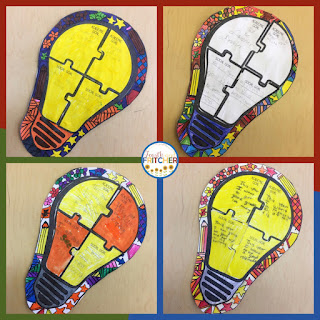Another year has passed and the holiday season is upon us once again. This is my favorite time of the year. Although I like to reflect on all the things to be thankful for on a regular and consistent basis, as this Thanksgiving approaches, I would like to especially thank someone who has made a tremendous impact on my life and my students' lives: Mary Beth from Brain Waves Instruction.
I learned about Brain Waves Instruction a year and a half ago. I started out using the free offerings and immediatly was impressed with the thoroughness and practicality of her resources. As time went on, I tried different resources (free and paid) and was amazed at the level of student response and engagement.
(Grades 3-5)
My students (and I) love these! I use them for the awkward 10 minutes I have in my schedule between specials and when students need to leave to go to providers for Guided Reading.
Students get one sheet per week. Terms are grouped by theme and students are asked to complete a vocab activity involving the term and then add their own doodle to reinforce the meaning.
We go over the term and definition for 5-7 minutes and then the students get their "2 minute doodle". Each word section is short enough that I can fit it in. They are powerful enough that the terms and definitions "stick" with the students. It was a great moment last month when a student recognized the term "constellation" within their novel study and connected it to the Daily Doodle Mary Beth had created that was themed around outer space. What a teaching win!
(Intermediate Grades and Middle School)
I admit that my poetry "game" is weak. I am always looking for resources to make it easier and less painful. Mary Beth has it all!
I teach 4th grade and most of her resources are designed for Middle School. But, I have found with a bit of slower pacing and introducing the nuts and bolts of the activity during small group instruction- fourth graders can do it.
I use this one to create an instant bulletin board in the spring. I copy the poetry paper on colored paper to give a bit more visual appeal to the board.
This was a great way to cover poetry and have some fun during Halloween. The students were having so much fun with the content and design of the resource, I don't think they realized how much they were learning.
(Intermediate Grades and Middle School)
I love EVERYTHING Doodle and Do! I am not exaggerating. If Mary Beth uses the term "doodle" anywhere near a resource- I want it!
Mary Beth offers a range of fiction and non-fiction skills. If you are looking for some carefully thought out, well paced instruction for a specific skill, you can't go wrong with a Doodle and Do.
These resources typically offer two options: use in a center or individual booklets. I usually have the Doodle and Do skill sets made into individualized student booklets (used during small group lessons).
For added fun, I sometimes have the students work through the booklets using a flair pen. Doodle and Do + Flair Pens = Happy Students.
My students love Doodle and Do so much they will work on the "extras" during their lunch and recess.
AWESOME COLLABORATIONS
Along with her amazing stuff in her Teachers Pay Teachers store, she also teams up with some equally amazing teachers to offer collaborative goodies!
Oftentimes, Mary Beth teams up with Jenny from Art with Jenny K. When these two get together I know I'm in for the best from both sides of the brain!
And, this past summer she teamed up with Rachael from The Classroom Nook to bring us "School Year Solutions: Getting Your Year in Gear".
 |
Students set 2 academic goals and 2 social goals in September.
Each goal was written into a puzzle piece.
The puzzle pieces fit together to make their light bulb! |
Mary Beth is also one of the coordinators for the TpT Flock (the annual Northeast Teachers Pay Teachers Meet Up). Her energetic personality and winning smile always makes for a memorable event.
Thank Mary Beth, for being an amazing individual and educator! I am so grateful to have met you! Your resources have helped make my classroom an engaging and meaningful place for me and my students.
Happy Thanksgiving!